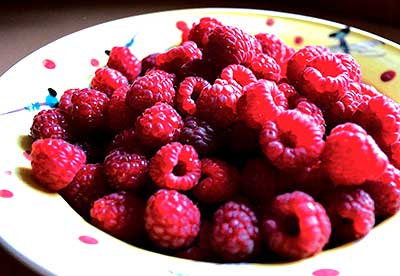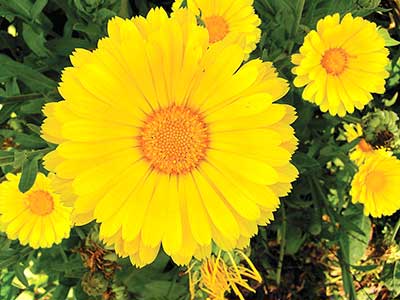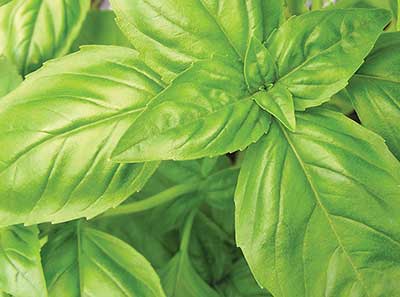 |
| Raspberry plants are abundantly productive and take only a small amount of work in the home garden. English photo |
 |
| Calendula is easy to grow, produces sunny bouquets and is used in medicinal salves and other skin-care products. English photo |
 |
| Pots of basil set on a deck are readily available for snipping. English photo |
By Joyce White
I’m gradually converting much of the lawn that came with my Stoneham, Maine, house into edibles, and the older I get, the closer berry plantings get to the house. Blackberry plants transplanted five years ago from my neighbor’s ancient patch produce luscious fruit in August, and I have already shortened the distance between them and the small deck.
One patch of raspberries that was supposed to be everbearing but bears only in July is gradually spreading toward the clothesline. Cane fruits do require pruning of dead canes but produce delicious food year after year with a small amount of effort. I have just enough lawn left between the raspberries and clothesline to set up the croquet set – so I have less lawn to mow, and clippings from the remaining lawn mulch the edibles.
When I moved here, I transplanted ‘Boyne’ raspberries into marginal land across my driveway. Once productive, the patch died after having wet feet for a whole summer. To my surprise, new shoots migrated up the hill to slightly drier land and are thriving. I’m nurturing them, whacking off weeds and ferns, and several bloomed this year. Boyne is the most productive raspberry I have grown, and I am happy to see it reestablishing in a spot more to its liking.
Cultivated blueberries near my house and a few near the garden often have lots of blooms and berries and promise, but once they ripen I usually get so few because of birds and chipmunks that I end up buying organic wild blueberries to freeze. I haven’t found a reliable way to keep these critters from taking most of my blueberries. Netting does keep the birds out but not the chipmunks, and it is a nuisance to work through and around.
Since I’ve given up growing strawberries in the ground to feed clever chipmunks and birds, I’ve tried container arrangements. Last year I planted 25 ‘Fort Laramie’ everbearing plants in three long plastic window boxes and one shorter wooden box, all fitted into a large wagon I bought at a yard sale. I ate luscious berries all summer, losing only a few to chipmunks, by pulling the wagon into the garage at night. The plants spent the winter in an unheated garage. This spring none of the plants in the plastic boxes put out new growth but those in the wooden box are making berries. I wonder if wrapping them in a quilt could have helped them survive, and I wonder what qualities in the wood protected them.
This year I grew a hothouse, gift strawberry plant with lovely red blooms, Fragaria ananassa ‘Red’, in a wooden blueberry box. It joined the remaining few Fort Laramies in the wagon. The first berry ripened on the solstice, its taste not as spectacular as its blossoms promised.
I prefer flowers with dual uses, so I grow Echinacea angustifolia close to the house now; deer routinely chomp those near the fenced vegetables. The long-lasting magenta blooms are lovely for cut flowers, and the leaves, flowers and stalks make good medicine. Chopped and steeped in vodka for six weeks to extract the medicinal properties, the liquid extract remaining after straining out the plant material helps prevent colds and flu. I leave most of the roots in the ground to grow again next year.
The annual Calendula officinalis needs to be planted each year (although some may reseed themselves). Its sunny yellow and orange blooms open in late June in their special bed near a small deck from seedlings I started inside in April. Calendula flowers make lively bouquets and powerful medicine, which is especially helpful for many skin problems as an external wash or poultice. An extract taken internally can combat inflammation and some digestive problems.
Statice, Limonium sinuatum, blooms from July until frost. I’m not aware of any medicinal uses, but I value the colorful small blooms in shades of pink, lavender, white and magenta for their long-lasting beauty alongside my main deck, as cut flowers and as dried flower bouquets for winter cheer and gifts.
Chives appear every spring in a corner by the deck, and I start small pots of basil, parsley and dill inside in March for early use. In mid-May I plant large pots of each, which sit on the deck for easy snipping all summer. Just as they reach snipping phase, I start another batch to grow until fall frost. Mint and lemon balm have their own separate spots close to the house but are segregated to contain their exuberant spread.
About the author: Joyce White gardens in Stoneham, Maine, and is a frequent contributor to The MOF&G. This article is for informational purposes only; please consult a health care practitioner for medical information.
